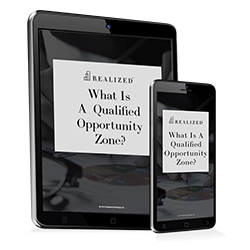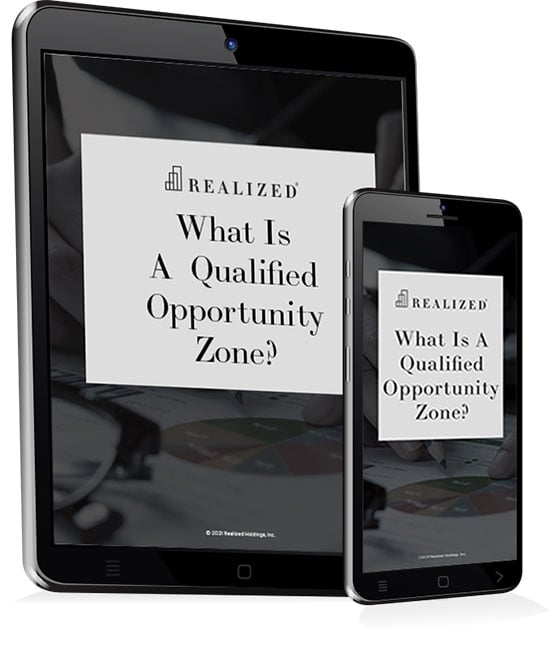
The recent Tax Cuts and Jobs Act enacted in December 2017 created yet another vehicle to defer capital gains for real estate investors, this time in the form of opportunity zones. This vehicle, the Qualified Opportunity Zone Fund (QOZF), is similar to 1031 exchanges, which are transactions that also allow investors to defer capital gains on real estate holdings at the time of disposal. However, QOZFs present to accredited investors the opportunity to defer gains realized from investments in stocks, bonds, businesses, and other alternative investment types in addition to gains realized from real estate investments.
Though these two modes of investment were created primarily to encourage investment and economic development and growth, they are not completely congruent. Before we discuss the differences, let us identify the similarities.
Similarities between QOZs and 1031 Exchanges
Qualified Opportunity Zones and 1031 exchanges are both instruments instituted into the United States tax code aimed to spur economic growth. While introduced nearly 100 years apart, they were both designed to allow investors to defer the recognition of gains on the sale of an investment or real estate holdings. The goal behind QOZs is fairly straightforward: by deferring the payment of capital gains taxes on such realized gains, investors hold more capital to reinvest into real estate and communities around the nation. The more capital invested into a community or region’s real estate markets, the higher the rate of growth that community will experience – a rising tide tends to lift all boats.
Though preferred outcomes are the same in the most macroeconomic sense, Qualified Opportunity Zones and 1031 exchanges are quite different when it comes to the structure of the investment and the rules governing it.
Differences between QOZs and 1031 Exchanges
Deferral. 1031 exchanges allow investors to defer taxes due on gains realized from the sale of an investment property. They do so by reinvesting proceeds obtained from the sale of the relinquished investment property into a similar type of real estate investment. If the investor decides to sell the replacement property after an unspecified period of time at a gain, he or she is once again eligible to defer the payment of taxes on these gains by participating in another 1031 exchange.
Investors can conduct 1031 exchanges in perpetuity as long as they follow the rules set by the Internal Revenue Service (IRS). Only when the investor chooses cash instead of equity in a replacement property is he or she is liable for the full taxable basis of the capital gains.
Like with 1031 exchanges, investing in Qualified Opportunity Funds offer investors the opportunity to defer capital gains. Opportunity Zones are designated by the IRS as economically-distressed communities where new investments are eligible for preferential tax treatment. Accredited investors can reap the potential benefits of this tax treatment by investing in a Qualified Opportunity Fund (QOF), which is an investment vehicle that takes the form of a partnership or corporation that is eligible to deploy capital gains in opportunity zones around the United States.
Investors are able to temporarily defer tax on any prior gains invested in a Qualified Opportunity Fund (QOF) until the earlier of the date on which the investment in the QOF is sold or exchanged, or December 31, 2026. As a result, investors participating in 1031 exchanges may be able to defer recognition of their gains for a longer period of time than investors with exposure to a Qualified Opportunity Fund if the 1031 property is still held after December 31, 2026, or if exchanges are continually conducted. 2026 is the end of the road for deferral of capital gains taxes held in a QOF.
To encourage investors to continue to hold investments in opportunity zones, the IRS created a series of incentives that provide further relief from capital gain tax liabilities:
- If an investor holds funds in a QOZ for 5 years, he or she is eligible for a 10 percent reduction on their original capital gain.
- If an investor holds funds in a QOZ for 7 years, he or she is eligible for an additional 5 percent reduction on the original capital gain resulting in a total deduction of 15 percent.
- If an investor holds funds in a QOZ for longer than 10 years, no payment will be due on any capital gains generated during the hold of the property from any appreciation within the fund they are invested into.
Property Type. The IRS provides a very broad scope for properties that are considered “like-kind,” or eligible to qualify as replacement properties in a 1031 exchange. Like-kind properties are considered properties of the same character or class. Most real estate is considered like-kind to other real estate, meaning that an office building can be disposed of in a 1031 exchange for a replacement property that may be a ranch, retail shopping plaza, or an apartment building. The stipulation? It must meet the requirements set by the IRS regarding the timing of the exchange and the fair market values of the assets.
In order to qualify for the preferential tax treatment available to investors as a result of the recent tax change, Qualified Opportunity Funds must invest directly in opportunity zones, defined broadly as low-income distressed communities. There are over 8,700 opportunity zones in all 50 states.
Three types of assets qualify for investment in an opportunity zone: a QOZ business, business property, or partnership interest. What this ultimately means is that QOFs can invest in both real estate and businesses in an opportunity zone, as long as they meet certain requirements.
What is the difference between investing in a Qualified Opportunity Fund and transacting a 1031 exchange?
Investing in a Qualified Opportunity Fund has similar tax incentives to a 1031 exchange because both options allow the investor to defer capital gains tax. However, in addition to the tax incentives discussed earlier in this article, there is a significant difference between these two investment vehicles:
Original Investment. When an investor executes a 1031 exchange, they must purchase a "like-kind" property that qualifies as real estate held for investment or for productive use in a trade or business.
A QOF, on the other hand, allows investors to defer the gains tax from the sale of stocks, bonds, business sales, and various other assets in addition to real estate. The "like-kind" rule doesn't apply when investing in a Qualified Opportunity Fund.
Tax Features & Liquidity. In a Qualified Opportunity Fund, the capital gains tax is deferred until December 31, 2026 or until the investor decides to sell the property – whichever comes first. In a 1031 exchange, an investor can hold onto a property as long as they choose, there is not a deadline as there is with Qualified Opportunity Zone investments. This means that, if an investor decides to hold onto a property in a 1031 exchange past the year 2026, they will defer taxes longer than they would in a Qualified Opportunity Zone investment.
Costs and Expenses. A Qualified Intermediary is required to complete a 1031 exchange. An intermediary is not required when investing in an Opportunity Zone, however. This can make the process more streamlined and may reduce overall costs and fees.
Step-Up in Basis. If a Qualified Opportunity Zone investment is held for ten years, the investor will not need to pay taxes on the portion of the property gain generated by the fund. This is because investors whose property is in a Qualified Opportunity Fund for ten years receive a step-up in basis on that property, increasing it to fair market value. Taxpayers are taxed on the capital gain, which is the difference between the basis and the sale price, so this makes the transaction tax-free. This does not exist with 1031 exchanges, however.
The Bottom Line
While similar in that 1031 exchanges and investments in Qualified Opportunity Zones provide tax incentives for investors, there are major differences between the two investment vehicles. 1031 exchanges provide investors the opportunity to defer capital gains in perpetuity. Conversely, QOZ investors are only able to defer capital gains realized on their initial investment in a business or property in an opportunity zone, and are liable for initial deferred capital gains taxes after a finite period of time. 1031 exchanges are limited to transactions involving like-kind real estate properties, whereas QOFs allow for exposure to businesses or real estate located in opportunity zones around the country.



